
Peccary collared
(Pecari tajacu)
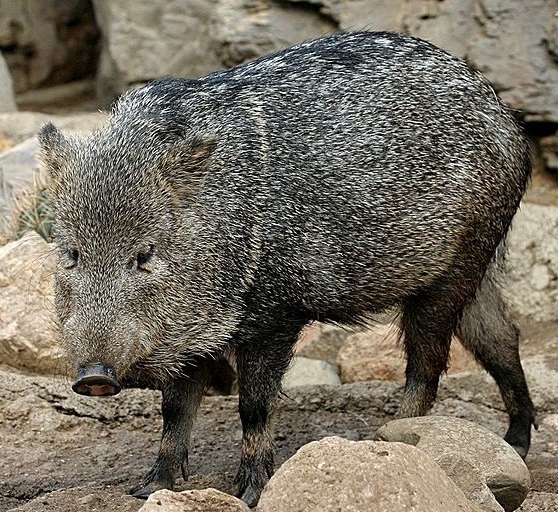
The wild boar, also known as the wild swine or Eurasian wild pig, is a suid native to much of Eurasia, North Africa, and the Greater Sunda Islands. Human intervention has spread its range further, making the species one of the widest-ranging mammals in the world, as well as the most widely spread suiform. Its wide range, high numbers, and adaptability mean that it is classed as least concern by the IUCN. The animal probably originated in Southeast Asia during the Early Pleistocene, and outcompeted other suid species as it spread throughout the Old World.
As of 1990, up to 16 subspecies are recognised, which are divided into four regional groupings based on skull height and lacrimal bone length. The species lives in matriarchal societies consisting of interrelated females and their young (both male and female). Fully grown males are usually solitary outside the breeding season. The grey wolf is the wild boar's main predator throughout most of its range except in the Far East and the Lesser Sunda Islands, where it is replaced by the tiger and Komodo dragon respectively. It has a long history of association with humans, having been the ancestor of most domestic pig breeds and a big-game animal for millennia.
Conservation status
Least conern
Scientific classification |
|
| Kingdom: | Animalia |
| Phylum: | Chordata |
| Class: | Mammalia |
| Order: | Artiodactyla |
| Family: | Tayassuidae |
| Genus: | Pecari |
| Specie: | Pecari tajacu |
Description
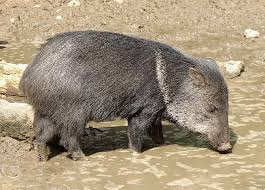
The wild boar is a bulky, massively built suid with short and relatively thin legs. The trunk is short and massive, while the hindquarters are comparatively underdeveloped. The region behind the shoulder blades rises into a hump, and the neck is short and thick, to the point of being nearly immobile. The animal's head is very large, taking up to one third of the body's entire length. The structure of the head is well suited for digging. The head acts as a plow, while the powerful neck muscles allow the animal to upturn considerable amounts of soil: it is capable of digging 8-10 cm (3.1-3.9 in) into frozen ground and can upturn rocks weighing 40-50 kg (88-110 lb). The eyes are small and deep-set, and the ears long and broad. The species has well developed canine teeth, which protrude from the mouths of adult males. The middle hooves are larger and more elongated than the lateral ones, and are capable of quick movements. The animal can run at a maximum speed of 40 km/h and jump at a height of 140-150 cm (55-59 in). Sexual dimorphism is very pronounced in the species, with males being typically 5-10% larger and 20-30% heavier than females. Males also sport a mane running down the back, which is particularly apparent during autumn and winter. The canine teeth are also much more prominent in males, and grow throughout life. The upper canines are relatively short and grow sideways early in life, though gradually curve upwards. The lower canines are much sharper and longer, with the exposed parts measuring 10-12 cm (3.9-4.7 in) in length. In the breeding period, males develop a coating of subcutaneous tissue, which may be 2-3 cm (0.79-1.18 in) thick, extending from the shoulder blades to the rump, thus protecting vital organs during fights. Males sport a roughly egg-sized sack near the opening of the penis, which collects urine and emits a sharp odour. The purpose of this is not fully understood.
Adult size and weight is largely determined by environmental factors; boars living in arid areas with little productivity tend to attain smaller sizes than their counterparts inhabiting areas with abundant food and water. In most of Europe, males average 75-100 kg (165-220 lb) in weight, 75-80 cm (30-31 in) in shoulder height and 150 cm (59 in) in body length, whereas females average 60-80 kg (130-180 lb) in weight, 70 cm (28 in) in shoulder height and 140 cm (55 in) in body length. In Europe's Mediterranean regions, males may reach average weights as low as 50 kg (110 lb) and females 45 kg (99 lb), with shoulder heights of 63-65 cm (25-26 in). In the more productive areas of Eastern Europe, males average 110-130 kg (240-290 lb) in weight, 95 cm (37 in) in shoulder height and 160 cm (63 in) in body length, while females weigh 95 kg (209 lb), reach 85-90 cm (33-35 in) in shoulder height and 145 cm (57 in) in body length. In Western and Central Europe, the largest males weigh 200 kg (440 lb) and females 120 kg (260 lb). In Eastern Europe, large males can reach brown bear-like sizes, weighing 270 kg (600 lb) and measuring 110-118 cm (43-46 in) in shoulder height. Some adult males in Ussuriland and Manchuria have been recorded to weigh 300-350 kg (660-770 lb) and measure 125 cm (49 in) in shoulder height. Adults of this size are generally immune from wolf predation. Such giants are rare in modern times, due to past overhunting preventing animals from attaining their full growth.
The winter coat consists of long, coarse bristles underlaid with short brown downy fur. The length of these bristles varies along the body, with the shortest being around the face and limbs and the longest running along the back. These back bristles form the aforementioned mane prominent in males, and stand erect when the animal is agitated. Colour is highly variable; specimens around Lake Balkhash are very lightly coloured, and can even be white, while some boars from Belarus and Ussuriland can be black. Some subspecies sport a light coloured patch running backwards from the corners of the mouth. Coat colour also varies with age, with piglets having light brown or rusty-brown fur with pale bands extending from the flanks and back.
Social behavior and life cycle
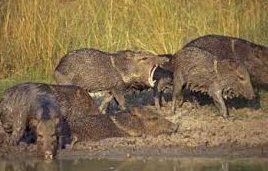
Boars are typically social animals, living in female-dominated sounders consisting of barren sows and mothers with young led by an old matriarch. Male boars leave their sounder at the age of 8-15 months, while females either remain with their mothers or establish new territories nearby. Subadult males may live in loosely knit groups, while adult and elderly males tend to be solitary outside the breeding season.
The breeding period in most areas lasts from November to January, though most mating only lasts a month and a half. Prior to mating, the males develop their subcutaneous armour, in preparation for confronting rivals. The testicles double in size and the glands secrete a foamy yellowish liquid. Once ready to reproduce, males travel long distances in search of a sounder of sows, eating little on the way. Once a sounder has been located, the male drives off all young animals and persistently chases the sows. At this point, the male fiercely fights potential rivals, A single male can mate with 5-10 sows. By the end of the rut, males are often badly mauled and have lost 20% of their body weight, with bite-induced injuries to the penis being common. The gestation period varies according to the age of the expecting mother. For first time breeders, it lasts 114-130 days, while it lasts 133-140 days in older sows. Farrowing occurs between March and May, with litter sizes depending on the age and nutrition of the mother. The average litter consists of 4-6 piglets, with the maximum being 10-12. The piglets are whelped in a nest constructed from twigs, grasses and leaves. Should the mother die prematurely, the piglets are adopted by the other sows in the sounder.
Newborn piglets weigh around 600-1,000 grams, lacking underfur and bearing a single milk incisor and canine on each half of the jaw. There is intense competition between the piglets over the most milk-rich nipples, as the best fed young grow faster and have stronger constitutions. The piglets do not leave the lair for their first week of life. Should the mother be absent, the piglets lie closely pressed to each other. By two weeks of age, the piglets begin accompanying their mother on her journeys. Should danger be detected, the piglets take cover or stand immobile, relying on their camouflage to keep them hidden. The neonatal coat fades after three months, with adult colouration being attained at eight months. Although the lactation period lasts 2.5-3.5 months, the piglets begin displaying adult feeding behaviours at the age of 2-3 weeks. The permanent dentition is fully formed by 1-2 years. With the exception of the canines in males, the teeth stop growing during the middle of the fourth year. The canines in old males continue to grow throughout their lives, curving strongly as they age. Sows attain sexual maturity at the age of one year, with males attaining it a year later. However, estrus usually first occurs after two years in sows, while males begin participating in the rut after 4-5 years, as they are not permitted to mate by the older males. The maximum lifespan in the wild is 10-14 years, though few specimens survive past 4-5 years. Boars in captivity have lived for 20 years.
Habitat
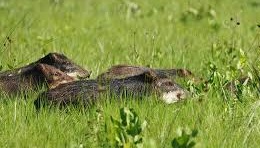
The wild boar inhabits a diverse array of habitats from boreal taigas to deserts. In mountainous regions, it can even occupy alpine zones, occurring up to 1,900 metres in the Carpathians, 2,600 metres in the Caucasus and up to 3,600-4,000 metres in the mountains in Central Asia and Kazakhstan. In order to survive in a given area, wild boars require a habitat fulfilling three conditions: heavily brushed areas providing shelter from predators, water for drinking and bathing purposes and an absence of regular snowfall. The main habitats favoured by boars in Europe are deciduous and mixed forests, with the most favourable areas consisting of forest composed of oak and beech enclosing marshes and meadows. In the Biaowiea Forest, the animal's primary habitat consists of well developed, broad-leaved and mixed forests, along with marshy mixed forests, with coniferous forests and undergrowths being of secondary importance. Forests made up entirely of oak groves and beech are used only during the fruit-bearing season. This is in contrast to the Caucasian and Transcaucasian mountain areas, where boars will occupy such fruit-bearing forests year-round. In the mountainous areas of the Russian Far East, the species inhabits nutpine groves, hilly mixed forests where Mongolian oak and Korean pine are present, swampy mixed taiga and coastal oak forests. In Transbaikalia, boars are restricted to river valleys with nutpine and shrubs. Boars are regularly encountered in pistachio groves in winter in some areas of Tajikistan and Turkmenia, while in spring they migrate to open deserts; boar have also colonised deserts in several areas they have been introduced to. On the islands of Komodo and Rinca, the boar mostly inhabits savanna or open monsoon forests, avoiding heavily forested areas unless pursued by humans. Wild boar are known to be competent swimmers, capable of covering long distances. In 2013, one boar was reported to have completed the seven mile swim from France to Alderney in the Channel Islands. Due to concerns about disease it was shot and incinerated.
Wild boar rest in shelters, which contain insulating material like spruce branches and dry hay. These resting places are occupied by whole families (though males lie separately), and are often located in the vicinity of streams, in swamp forests, in tall grass or shrub thickets. Boars never defecate in their shelters, and will cover themselves with soil and pine needles when irritated by insects.
Diet
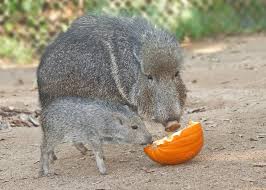
The wild boar is a highly versatile omnivore, whose diversity in choice of food rivals that of humans.
A 50 kg (110 lb) boar needs around 4,000-4,500 calories of food per day, though this required amount increases during winter and pregnancy, with the majority of its diet consisting of food items dug from the ground like underground plant material and burrowing animals. Acorns and beechnuts are invariably its most important food items in temperate zones, as they are rich in the carbohydrates necessary for the buildup of fat reserves needed to survive lean periods. In Western Europe, underground plant material favoured by boars includes bracken, willow herb, bulbs, meadow herb roots and bulbs, and the bulbs of cultivated crops. Such food is favoured in early spring and summer, but may also be eaten in autumn and winter during beechnut and acorn crop failures. Should regular wild foods become scarce, boars will eat tree bark and fungi, as well as visit cultivated potato and artichoke fields. Boar soil disturbance and foraging have been shown to facilitate invasive plants. Boars of the vittatus subspecies in Ujung Kulon National Park in Java differ from most other populations by their primarily frugivorous diet, which consists of 50 different fruit species, especially figs, thus making them important seed dispersers. The wild boar can consume numerous genera of poisonous plants without ill effect, including Aconitum, Anemone, Calla, Caltha, Ferula, and Pteridium.
Boars may occasionally prey on small vertebrates like newborn deer fawns, leporids and galliform chicks. Boars inhabiting the Volga Delta and near some lakes and rivers of Kazakhstan have been recorded to feed extensively on fish like carp and Caspian roach. Boars in the former area will also feed on cormorant and heron chicks, bivalved molluscs, trapped muskrats and mice. There is at least one record of a boar killing and eating a bonnet macaque in southern India's Bandipur National Park, though this may have been a case of intraguild predation, brought on by interspecific competition for human handouts.
Range
The species originally occurred in North Africa and much of Eurasia; from the British Isles to Korea and the Sunda Islands. The northern limit of its range extended from southern Scandinavia to southern Siberia and Japan. Within this range, it was only absent in extremely dry deserts and alpine zones. It was once found in North Africa along the Nile valley up to Khartum and north of the Sahara. The species occurs on a few Ionian and Aegean Islands, sometimes swimming between islands. The reconstructed northern boundary of the animal's Asian range ran from Lake Ladoga (at 60°N) through the area of Novgorod and Moscow into the southern Urals, where it reached 52°N. From there, the boundary passed Ishim and farther east the Irtysh at 56°N. In the eastern Baraba steppe (near Novosibirsk) the boundary turned steep south, encircled the Altai Mountains, and went again eastward including the Tannu-Ola Mountains and Lake Baikal. From here the boundary went slightly north of the Amur River eastward to its lower reaches at the Sea of Okhotsk. On Sakhalin, there are only fossil reports of wild boar. The southern boundaries in Europe and Asia were almost invariably identical to the sea shores of these continents. It is absent in the dry regions of Mongolia from 44-46°N southward, in China westward of Sichuan and in India north of the Himalayas. It is absent in the higher elevations of Pamir and Tien Shan, though they do occur in the Tarim basin and on the lower slopes of the Tien Shan.In recent centuries, the range of wild boar has changed dramatically, largely due to hunting by humans and more recently because of captive wild boar escaping into the wild. Prior to the 20th century, boar populations had declined in numerous areas, with British populations probably becoming extinct during the 13th century. In Denmark, the last boar was shot at the beginning of the 19th century, and in 1900 they were absent in Tunisia and Sudan and large areas of Germany, Austria, and Italy. In Russia they were extirpated in wide areas in the 1930s. The last boar in Egypt reportedly died on 20 December 1912 in the Giza Zoo, with wild populations having disappeared around 1894-1902. Prince Kamal el Dine Hussein attempted to repopulate Wadi El Natrun with boars of Hungarian stock, but they were quickly exterminated by poachers.
A revival of boar populations began in the middle of the 20th century. By 1950 wild boar had once again reached their original northern boundary in many parts of their Asiatic range. By 1960, they reached Leningrad and Moscow, and by 1975 they were to be found in Archangelsk and Astrakhan. In the 1970s they again occurred in Denmark and Sweden, where captive animals escaped and now survive in the wild. In England, wild boar populations re-established themselves in the 1990s, after escaping from specialist farms that had imported European stock.
Zoológico de Vallarta A. C.
Leave your comments, your opinion is important to us

